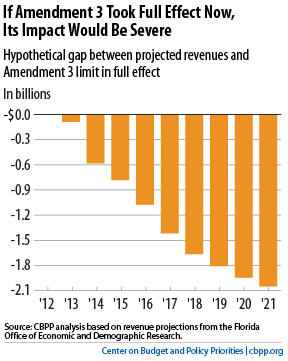BEYOND THE NUMBERS
Florida is the latest battleground in an ongoing effort by national anti-government organizations to push for severe revenue limits in state constitutions.
As our new report explains, the question of whether to restrict annual revenue growth to inflation and population growth will go before Florida voters this November. The proposal is based on Colorado’s TABOR (or “Taxpayer Bill of Rights”) — a failed experiment that caused so much damage to public services like education and health care that voters suspended it.
Proponents have pushed TABORs throughout the country over the years, but without success. Over 30 state legislatures have considered and rejected them — some, including Florida, multiple times. Voters in four states have rejected them, too.

To illustrate its potential harm, we calculate that if the measure took full effect today rather than several years from now, it would cost the state more than $11 billion in just ten years (see graph).
Florida’s kids, communities, and economy would suffer. It would be nearly impossible to address revenue losses that large without cutting education funding, since nearly half of the revenues subject to Amendment 3’s limit support public schools and universities. Health services for children and the elderly also would face cuts. And Amendment 3 would make it much more difficult to build and maintain schools, roads, and other infrastructure projects.
Amendment 3’s fundamental flaw, as we detail here, is its arbitrary population-and-inflation formula, which doesn’t accurately reflect changes in the cost of public services:
- It is based on overall state population growth rather than growth among groups to whom many public services are targeted, such as children and seniors. For example, Florida projects its senior population will grow by 87 percent between 2010 and 2030, three times faster than the overall population.
- Its inflation measure reflects changes in the price of the goods and services bought by an average consumer in a U.S. city: mostly housing, transportation, and food and beverages. By contrast, Florida spends its revenue mostly on education, health care, corrections, and roads — an entirely different set of goods, and one whose costs have risen much faster than the goods that individual consumers buy.
This formula would put a stranglehold on Florida just as it did in Colorado. Voters in Colorado suspended TABOR to temporarily break free of its grip. Florida voters should heed that lesson.
